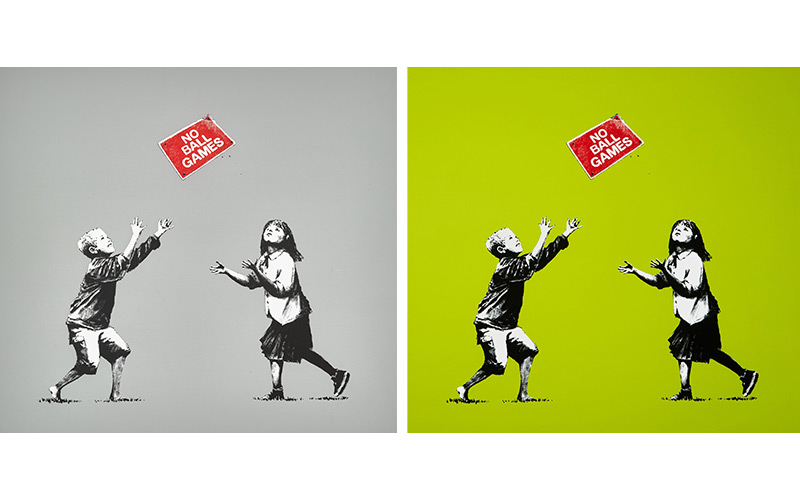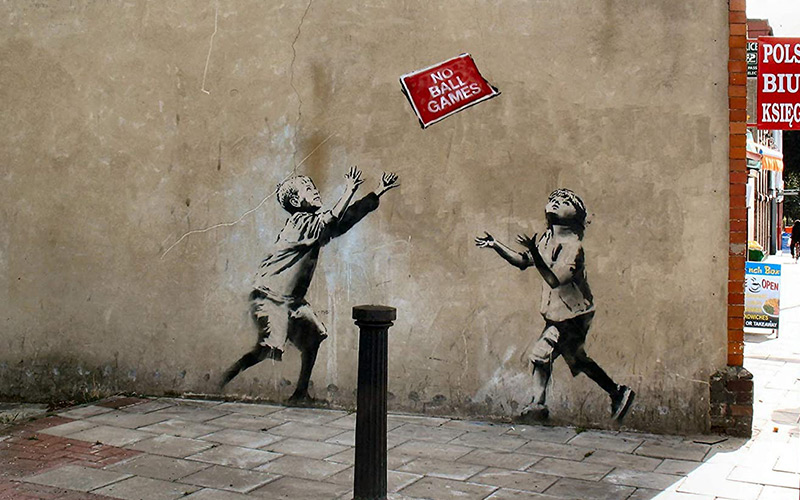

Banksy’s No Ball Games eludes to a liberation of childhood and children’s exemption from life’s rules and expectations. The children are in an area not designed for fun and play, but do so in defiance without a care going so far as to toss the sign as if it were said ball they aren’t allowed to play with, a loophole they found in the strict rules. It first appeared on canvas in 2006 at Banksy’s “Barely Legal” Exhibition in Los Angeles. In 2009 Banksy sold 250 signed prints of No Ball Games with green or grey backgrounds. No Ball Games was sprayed in the same year on a shop wall at the junction between Tottenham High Road and Philip Lane, North London, but has been removed and sold by the Sincura group in 2013, at an estimated £500,000, with the profits going to help disadvantaged children. It was taken down by the group as part of their controversial “Stealing Banksy” project.
Banksys No Ball Games verweist auf die Befreiung der Kinder von den Regeln und Erwartungen des Lebens. Die Kinder befinden sich in einem Bereich, der nicht zum Spielen bestimmt ist. Trotzdem werfen Sie sich aber sorglos ein Schild mit der Aufschrift „keine Ballspiele“ zu, als ob es ein Ball wäre. Sie finden quasi ein Schlupfloch in dem spaßverderbendem Verbot. Die erste Version dieses Motivs war 2006 als Leinwanddruck bei Banksys Ausstellung „Barely Legal“ zu sehen. 2009 verkaufte Banksy 250 signierte Drucke von No Ball Games mit grünem oder grauem Hintergrund. Im selben Jahr wurde „No Ball Games“ an eine Mauer an der Kreuzung zwischen Tottenham High Road und Philip Lane, North London gesprüht und für geschätzte 500.000 US-Dollar von der Sincura-Gruppe verkauft, nachdem es von ihnen dort im Rahmen ihres umstrittenen „Stealing Banksy“-Projekts entfernt wurde. Die Gewinne sollten benachteiligten Kindern zukommen.
No Ball Games fait référence à la libération de l’enfance et à l’exemption des enfants des règles et des attentes de la vie. Les enfants se trouvent dans un espace qui n’est pas conçu pour le plaisir et le jeu, mais ils y jouent néanmoins, défiant les interdictions en se passant le panneau « No Ball Games » (jeu de ballon interdit), comme s’il s’agissait de la balle qu’ils n’ont pas le droit d’utiliser. Une faille qu’ils ont trouvée dans les règles strictes. L’œuvre est apparue pour la première fois sur toile en 2006 lors de l’exposition Barely Legal de Banksy à Los Angeles. En 2009, Banksy a vendu 250 tirages signés de No Ball Games avec des arrière-plans verts ou gris. No Ball Games a été peint la même année sur le mur d’un magasin à l’intersection de Tottenham High Road et Philip Lane, dans le nord de Londres, mais a été enlevé et vendu par le groupe Sincura en 2013, pour une estimation de 500 000 £, les bénéfices étant destinés à aider les enfants défavorisés. L’œuvre a été retirée par le groupe dans le cadre de leur projet controversé « Stealing Banksy ».
No Ball Games Banksy’ego nawiązuje do wyzwolenia dzieciństwa i zwolnienia dzieci z życiowych zasad i oczekiwań. Dzieci znajdują się na obszarze, który nie jest przeznaczony do zabawy, ale robią to wbrew sobie. Nie przejmują się niczym, nawet rzucają znakiem, jakby to była piłka, którą nie wolno im się bawić, luką, którą znalazły w surowych zasadach. Po raz pierwszy pojawił się na płótnie w 2006 roku na wystawie Banksy’ego „Barely Legal” w Los Angeles. W 2009 roku Banksy sprzedał 250 podpisanych odbitek No Ball Games z zielonym lub szarym tłem. Napis No Ball Games został namalowany w tym samym roku na ścianie sklepu na skrzyżowaniu Tottenham High Road i Philip Lane w północnym Londynie, ale usunięto go i sprzedano przez grupę Sincura w 2013 roku za około 500 000 funtów, a zyski przeznaczono na pomoc dzieciom pokrzywdzonym przez los. Został on usunięty w ramach kontrowersyjnego projektu „Stealing Banksy”.